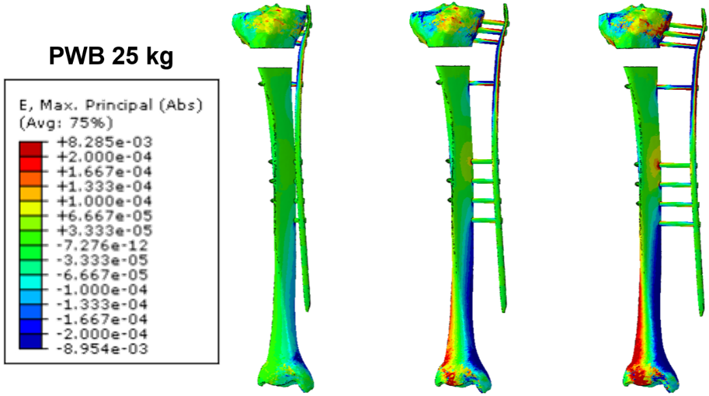Stability of externalized locked plating of unstable proximal tibia fractures under partial weightbearing
Background
Osteosynthesis of high-energy metaphyseal proximal tibia fractures is still challenging, especially in patients with severe soft tissue injuries and/or short stature. Although the use of external fixators is the traditional treatment of choice for open comminuted fractures, patients' acceptance is low due to the high profile and therefore the physical burden of the devices. Recently, clinical case reports have shown that supercutaneous locked plating used as definite external fixation could be an efficient alternative.
Goal
To evaluate the effect of implant configuration on stability and interfragmentary motions of unstable proximal tibia fractures fixed by means of externalized locked plating.
Results
A finite element model of unstable proximal tibia fracture AO 41-C2.2, simulated via 2 cm osteotomy gap located 5 cm distally to the articular surface, was developed based on CT scan of a 48 years-old male donor, to compare the stability of one internal and two different externalized plate fixations with a medial stainless steel LISS-DF plate: (1) with 2 mm plate elevation (internal locked plating), (2) with 22 mm plate elevation (externalized locked plating with thin soft tissue simulation), and (3) with 32 mm plate elevation (externalized locked plating with thick soft tissue simulation). Axial loads of 25 kg (partial weightbearing) and 80 kg (full weightbearing) were virtually applied to the proximal tibia end and distributed at a ratio of 80% to 20% on the medial and lateral condyles, respectively.
From virtual biomechanics point of view, externalized locked plating of unstable proximal tibia fractures with simulated thin and thick soft tissue environment seems to ensure favorable conditions for callus formation with longitudinal strains at the fracture site not exceeding 10%, thus providing appropriate relative stability for secondary bone healing under partial weightbearing during the early postoperative phase.
Fund:
Trakia University, Stara Zagora, Bulgaria, EUR 2'500. Period: 2017
-
Publication
Makelov B, Silva JD, Apivatthakakul T, Gueorguiev B, Varga P. Externalized locked plating of unstable high energy proximal tibia fractures – a FEA Study, Bul J Ortop Trauma. 2019,56(3):124-138
Makelov B, Silva JD, Apivatthakakul T, Peeva K, Kavrykov T. Externalized metaphyseal locked plating of complex proximal tibial fractures – clinical and biomechanical outcomes, J Science & Research. 2019,3(1):55-66
-
Presentation
Makelov B, Silva JD, Apivatthakakul T, Gueorguiev B, Varga P. Externalized locked plating of unstable proximal tibia fractures can provide sufficient stability under partial weightbearing – a finite element study. 2019, EFORT, Lisbon, Portugal (oral)
Makelov B, Zderic I, Silva JD, Apivatthakakul T, Gueorguiev B, Varga P. Externalized locked plating of unstable proximal tibia fractures can provide sufficient stability under partial weightbearing – a finite element study. 2019, EORS, Maastricht, Netherlands (oral)
Makelov B, Silva JD, Apivatthakakul T, Gueorguiev B, Varga P. External one-staged locked plating of unstable proximal tibia fractures can provide callus formation and sufficient stability under partial weightbearing – a finite element study. 2019, BOTA, Varna, Bulgaria (poster)
-
Partner
Makelov B (MD), University Multiprofile Hospital for Active Treatment 'Prof Stoyan Kirkovitch', Stara Zagora, Bulgaria
Apivatthakakul T (Prof), Chiang Mai University Hospital, Thailand
Silva JD, Karl Landsteiner Privatuniversität für Gesundheitswissenschaften, Austria


